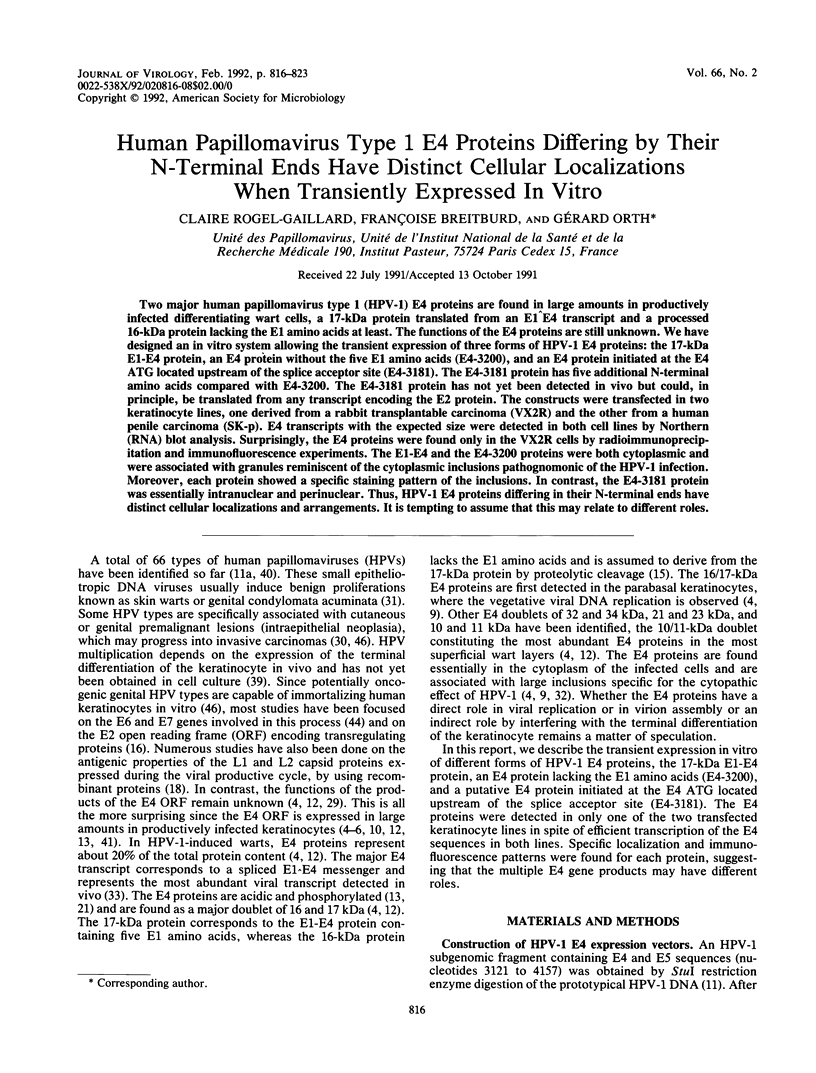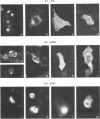Abstract
Two major human papillomavirus type 1 (HPV-1) E4 proteins are found in large amounts in productively infected differentiating wart cells, a 17-kDa protein translated from an E1-E4 transcript and a processed 16-kDa protein lacking the E1 amino acids at least. The functions of the E4 proteins are still unknown. We have designed an in vitro system allowing the transient expression of three forms of HPV-1 E4 proteins: the 17-kDa E1-E4 protein, an E4 protein without the five E1 amino acids (E4-3200), and E4 protein initiated at the E4 ATG located upstream of the splice acceptor site (E4-3181). The E4-3181 protein has five additional N-terminal amino acids compared with E4-3200. The E4-3181 protein has not yet been detected in vivo but could, in principle, be translated from any transcript encoding the E2 protein. The constructs were transfected in two keratinocyte lines, one derived from a rabbit transplantable carcinoma (VX2R) and the other from a human penile carcinoma (SK-p). E4 transcripts with the expected size were detected in both cell lines by Northern (RNA) blot analysis. Surprisingly, the E4 proteins were found only in the VX2R cells by radioimmunoprecipitation and immunofluorescence experiments. The E1-E4 and the E4-3200 proteins were both cytoplasmic and were associated with granules reminiscent of the cytoplasmic inclusions pathognomonic of the HPV-1 infection. Moreover, each protein showed a specific staining pattern of the inclusions. In contrast, the E4-3181 protein was essentially intranuclear and perinuclear. Thus, HPV-1 E4 proteins differing in their N-terminal ends have distinct cellular localizations and arrangements. It is tempting to assume that this may relate to different roles.
Full text
PDF







Images in this article
Selected References
These references are in PubMed. This may not be the complete list of references from this article.
- Bohjanen P. R., Petryniak B., June C. H., Thompson C. B., Lindsten T. An inducible cytoplasmic factor (AU-B) binds selectively to AUUUA multimers in the 3' untranslated region of lymphokine mRNA. Mol Cell Biol. 1991 Jun;11(6):3288–3295. doi: 10.1128/mcb.11.6.3288. [DOI] [PMC free article] [PubMed] [Google Scholar]
- Brown D. R., Bryan J., Rodriguez M., Rose R. C., Strike D. G. Detection of human papillomavirus types 6 and 11 E4 gene products in condylomata acuminatum. J Med Virol. 1991 May;34(1):20–28. doi: 10.1002/jmv.1890340105. [DOI] [PubMed] [Google Scholar]
- Brown D. R., Chin M. T., Strike D. G. Identification of human papillomavirus type 11 E4 gene products in human tissue implants from athymic mice. Virology. 1988 Jul;165(1):262–267. doi: 10.1016/0042-6822(88)90680-0. [DOI] [PubMed] [Google Scholar]
- Chen C., Okayama H. High-efficiency transformation of mammalian cells by plasmid DNA. Mol Cell Biol. 1987 Aug;7(8):2745–2752. doi: 10.1128/mcb.7.8.2745. [DOI] [PMC free article] [PubMed] [Google Scholar]
- Chow L. T., Nasseri M., Wolinsky S. M., Broker T. R. Human papillomavirus types 6 and 11 mRNAs from genital condylomata acuminata. J Virol. 1987 Aug;61(8):2581–2588. doi: 10.1128/jvi.61.8.2581-2588.1987. [DOI] [PMC free article] [PubMed] [Google Scholar]
- Croissant O., Breitburd F., Orth G. Specificity of cytopathic effect of cutaneous human papillomaviruses. Clin Dermatol. 1985 Oct-Dec;3(4):43–55. doi: 10.1016/0738-081x(85)90048-3. [DOI] [PubMed] [Google Scholar]
- Crum C. P., Barber S., Symbula M., Snyder K., Saleh A. M., Roche J. K. Coexpression of the human papillomavirus type 16 E4 and L1 open reading frames in early cervical neoplasia. Virology. 1990 Sep;178(1):238–246. doi: 10.1016/0042-6822(90)90399-c. [DOI] [PubMed] [Google Scholar]
- Danos O., Katinka M., Yaniv M. Human papillomavirus 1a complete DNA sequence: a novel type of genome organization among papovaviridae. EMBO J. 1982;1(2):231–236. doi: 10.1002/j.1460-2075.1982.tb01152.x. [DOI] [PMC free article] [PubMed] [Google Scholar]
- Doorbar J., Campbell D., Grand R. J., Gallimore P. H. Identification of the human papilloma virus-1a E4 gene products. EMBO J. 1986 Feb;5(2):355–362. doi: 10.1002/j.1460-2075.1986.tb04219.x. [DOI] [PMC free article] [PubMed] [Google Scholar]
- Doorbar J., Coneron I., Gallimore P. H. Sequence divergence yet conserved physical characteristics among the E4 proteins of cutaneous human papillomaviruses. Virology. 1989 Sep;172(1):51–62. doi: 10.1016/0042-6822(89)90106-2. [DOI] [PubMed] [Google Scholar]
- Doorbar J., Ely S., Sterling J., McLean C., Crawford L. Specific interaction between HPV-16 E1-E4 and cytokeratins results in collapse of the epithelial cell intermediate filament network. Nature. 1991 Aug 29;352(6338):824–827. doi: 10.1038/352824a0. [DOI] [PubMed] [Google Scholar]
- Doorbar J., Evans H. S., Coneron I., Crawford L. V., Gallimore P. H. Analysis of HPV-1 E4 gene expression using epitope-defined antibodies. EMBO J. 1988 Mar;7(3):825–833. doi: 10.1002/j.1460-2075.1988.tb02881.x. [DOI] [PMC free article] [PubMed] [Google Scholar]
- Fuchs E. Epidermal differentiation: the bare essentials. J Cell Biol. 1990 Dec;111(6 Pt 2):2807–2814. doi: 10.1083/jcb.111.6.2807. [DOI] [PMC free article] [PubMed] [Google Scholar]
- Galloway D. A., Jenison S. A. Characterization of the humoral immune response to genital papillomaviruses. Mol Biol Med. 1990 Feb;7(1):59–72. [PubMed] [Google Scholar]
- Georges E., Breitburd F., Jibard N., Orth G. Two Shope papillomavirus-associated VX2 carcinoma cell lines with different levels of keratinocyte differentiation and transplantability. J Virol. 1985 Jul;55(1):246–250. doi: 10.1128/jvi.55.1.246-250.1985. [DOI] [PMC free article] [PubMed] [Google Scholar]
- Gorman C. M., Merlino G. T., Willingham M. C., Pastan I., Howard B. H. The Rous sarcoma virus long terminal repeat is a strong promoter when introduced into a variety of eukaryotic cells by DNA-mediated transfection. Proc Natl Acad Sci U S A. 1982 Nov;79(22):6777–6781. doi: 10.1073/pnas.79.22.6777. [DOI] [PMC free article] [PubMed] [Google Scholar]
- Grand R. J., Doorbar J., Smith K. J., Coneron I., Gallimore P. H. Phosphorylation of the human papillomavirus type 1 E4 proteins in vivo and in vitro. Virology. 1989 May;170(1):201–213. doi: 10.1016/0042-6822(89)90367-x. [DOI] [PubMed] [Google Scholar]
- Hunt T. Cytoplasmic anchoring proteins and the control of nuclear localization. Cell. 1989 Dec 22;59(6):949–951. doi: 10.1016/0092-8674(89)90747-2. [DOI] [PubMed] [Google Scholar]
- Jackson R. J., Standart N. Do the poly(A) tail and 3' untranslated region control mRNA translation? Cell. 1990 Jul 13;62(1):15–24. doi: 10.1016/0092-8674(90)90235-7. [DOI] [PubMed] [Google Scholar]
- Kozak M. The scanning model for translation: an update. J Cell Biol. 1989 Feb;108(2):229–241. doi: 10.1083/jcb.108.2.229. [DOI] [PMC free article] [PubMed] [Google Scholar]
- McCall C. A., Cohen J. J. Programmed cell death in terminally differentiating keratinocytes: role of endogenous endonuclease. J Invest Dermatol. 1991 Jul;97(1):111–114. doi: 10.1111/1523-1747.ep12478519. [DOI] [PubMed] [Google Scholar]
- Nasseri M., Hirochika R., Broker T. R., Chow L. T. A human papilloma virus type 11 transcript encoding an E1--E4 protein. Virology. 1987 Aug;159(2):433–439. doi: 10.1016/0042-6822(87)90482-x. [DOI] [PubMed] [Google Scholar]
- Neary K., Horwitz B. H., DiMaio D. Mutational analysis of open reading frame E4 of bovine papillomavirus type 1. J Virol. 1987 Apr;61(4):1248–1252. doi: 10.1128/jvi.61.4.1248-1252.1987. [DOI] [PMC free article] [PubMed] [Google Scholar]
- Orth G., Favre M. Human papillomaviruses. Biochemical and biologic properties. Clin Dermatol. 1985 Oct-Dec;3(4):27–42. doi: 10.1016/0738-081x(85)90047-1. [DOI] [PubMed] [Google Scholar]
- Orth G., Jablonska S., Favre M., Croissant O., Obalek S., Jarzabek-Chorzelska M., Jibard N. Identification of papillomaviruses in butchers' warts. J Invest Dermatol. 1981 Feb;76(2):97–102. doi: 10.1111/1523-1747.ep12525394. [DOI] [PubMed] [Google Scholar]
- Palermo-Dilts D. A., Broker T. R., Chow L. T. Human papillomavirus type 1 produces redundant as well as polycistronic mRNAs in plantar warts. J Virol. 1990 Jun;64(6):3144–3149. doi: 10.1128/jvi.64.6.3144-3149.1990. [DOI] [PMC free article] [PubMed] [Google Scholar]
- Saiki R. K., Scharf S., Faloona F., Mullis K. B., Horn G. T., Erlich H. A., Arnheim N. Enzymatic amplification of beta-globin genomic sequences and restriction site analysis for diagnosis of sickle cell anemia. Science. 1985 Dec 20;230(4732):1350–1354. doi: 10.1126/science.2999980. [DOI] [PubMed] [Google Scholar]
- Schneider-Maunoury S., Pehau-Arnaudet G., Breitburd F., Orth G. Expression of the human papillomavirus type 16 genome in SK-v cells, a line derived from a vulvar intraepithelial neoplasia. J Gen Virol. 1990 Apr;71(Pt 4):809–817. doi: 10.1099/0022-1317-71-4-809. [DOI] [PubMed] [Google Scholar]
- Seedorf K., Krämmer G., Dürst M., Suhai S., Röwekamp W. G. Human papillomavirus type 16 DNA sequence. Virology. 1985 Aug;145(1):181–185. doi: 10.1016/0042-6822(85)90214-4. [DOI] [PubMed] [Google Scholar]
- Silver P. A. How proteins enter the nucleus. Cell. 1991 Feb 8;64(3):489–497. doi: 10.1016/0092-8674(91)90233-o. [DOI] [PubMed] [Google Scholar]
- Taichman L. B., Breitburd F., Croissant O., Orth G. The search for a culture system for papillomavirus. J Invest Dermatol. 1984 Jul;83(1 Suppl):2s–6s. doi: 10.1111/1523-1747.ep12281108. [DOI] [PubMed] [Google Scholar]
- Tawheed A. R., Beaudenon S., Favre M., Orth G. Characterization of human papillomavirus type 66 from an invasive carcinoma of the uterine cervix. J Clin Microbiol. 1991 Nov;29(11):2656–2660. doi: 10.1128/jcm.29.11.2656-2660.1991. [DOI] [PMC free article] [PubMed] [Google Scholar]
- Tomita Y., Fuse A., Sekine H., Shirasawa H., Simizu B., Sugimoto M., Funahashi S. Human papillomavirus type 6 and 11 E4 gene products in condyloma acuminata. J Gen Virol. 1991 Mar;72(Pt 3):731–734. doi: 10.1099/0022-1317-72-3-731. [DOI] [PubMed] [Google Scholar]
- Vakalopoulou E., Schaack J., Shenk T. A 32-kilodalton protein binds to AU-rich domains in the 3' untranslated regions of rapidly degraded mRNAs. Mol Cell Biol. 1991 Jun;11(6):3355–3364. doi: 10.1128/mcb.11.6.3355. [DOI] [PMC free article] [PubMed] [Google Scholar]
- Van Etten R. A., Jackson P., Baltimore D. The mouse type IV c-abl gene product is a nuclear protein, and activation of transforming ability is associated with cytoplasmic localization. Cell. 1989 Aug 25;58(4):669–678. doi: 10.1016/0092-8674(89)90102-5. [DOI] [PubMed] [Google Scholar]
- Zachow K. R., Ostrow R. S., Faras A. J. Nucleotide sequence and genome organization of human papillomavirus type 5. Virology. 1987 May;158(1):251–254. doi: 10.1016/0042-6822(87)90263-7. [DOI] [PubMed] [Google Scholar]
- de Villiers E. M. Heterogeneity of the human papillomavirus group. J Virol. 1989 Nov;63(11):4898–4903. doi: 10.1128/jvi.63.11.4898-4903.1989. [DOI] [PMC free article] [PubMed] [Google Scholar]
- zur Hausen H. Papillomaviruses in anogenital cancer as a model to understand the role of viruses in human cancers. Cancer Res. 1989 Sep 1;49(17):4677–4681. [PubMed] [Google Scholar]






